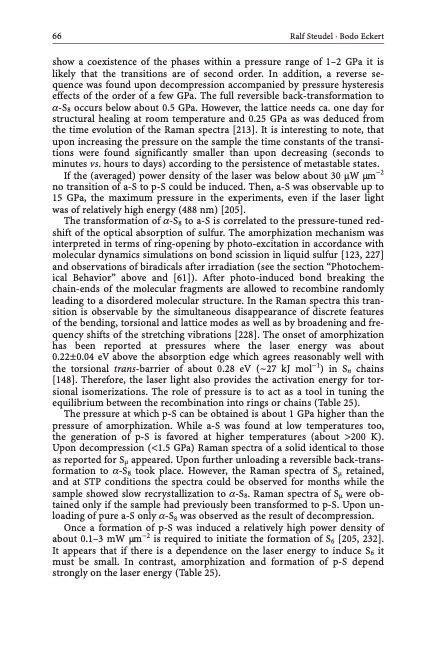
PDF Publication Title:
Text from PDF Page: 076
66 Ralf Steudel · Bodo Eckert show a coexistence of the phases within a pressure range of 1–2 GPa it is likely that the transitions are of second order. In addition, a reverse se- quence was found upon decompression accompanied by pressure hysteresis effects of the order of a few GPa. The full reversible back-transformation to a-S8 occurs below about 0.5 GPa. However, the lattice needs ca. one day for structural healing at room temperature and 0.25 GPa as was deduced from the time evolution of the Raman spectra [213]. It is interesting to note, that upon increasing the pressure on the sample the time constants of the transi- tions were found significantly smaller than upon decreasing (seconds to minutes vs. hours to days) according to the persistence of metastable states. If the (averaged) power density of the laser was below about 30 W m2 no transition of a-S to p-S could be induced. Then, a-S was observable up to 15 GPa, the maximum pressure in the experiments, even if the laser light was of relatively high energy (488 nm) [205]. The transformation of a-S8 to a-S is correlated to the pressure-tuned red- shift of the optical absorption of sulfur. The amorphization mechanism was interpreted in terms of ring-opening by photo-excitation in accordance with molecular dynamics simulations on bond scission in liquid sulfur [123, 227] and observations of biradicals after irradiation (see the section “Photochem- ical Behavior” above and [61]). After photo-induced bond breaking the chain-ends of the molecular fragments are allowed to recombine randomly leading to a disordered molecular structure. In the Raman spectra this tran- sition is observable by the simultaneous disappearance of discrete features of the bending, torsional and lattice modes as well as by broadening and fre- quency shifts of the stretching vibrations [228]. The onset of amorphization has been reported at pressures where the laser energy was about 0.22€0.04 eV above the absorption edge which agrees reasonably well with the torsional trans-barrier of about 0.28 eV (~27 kJ mol1) in Sn chains [148]. Therefore, the laser light also provides the activation energy for tor- sional isomerizations. The role of pressure is to act as a tool in tuning the equilibrium between the recombination into rings or chains (Table 25). The pressure at which p-S can be obtained is about 1 GPa higher than the pressure of amorphization. While a-S was found at low temperatures too, the generation of p-S is favored at higher temperatures (about >200 K). Upon decompression (<1.5 GPa) Raman spectra of a solid identical to those as reported for S appeared. Upon further unloading a reversible back-trans- formation to a-S8 took place. However, the Raman spectra of S retained, and at STP conditions the spectra could be observed for months while the sample showed slow recrystallization to a-S8. Raman spectra of S were ob- tained only if the sample had previously been transformed to p-S. Upon un- loading of pure a-S only a-S8 was observed as the result of decompression. Once a formation of p-S was induced a relatively high power density of about 0.1–3 mW m2 is required to initiate the formation of S6 [205, 232]. It appears that if there is a dependence on the laser energy to induce S6 it must be small. In contrast, amorphization and formation of p-S depend strongly on the laser energy (Table 25).PDF Image | Topics in Current Chemistry

PDF Search Title:
Topics in Current ChemistryOriginal File Name Searched:
Elemental-Sulfur-und-Sulfur-Rich-Compounds-I.pdfDIY PDF Search: Google It | Yahoo | Bing
Sulfur Deposition on Carbon Nanofibers using Supercritical CO2 Sulfur Deposition on Carbon Nanofibers using Supercritical CO2. Gamma sulfur also known as mother of pearl sulfur and nacreous sulfur... More Info
CO2 Organic Rankine Cycle Experimenter Platform The supercritical CO2 phase change system is both a heat pump and organic rankine cycle which can be used for those purposes and as a supercritical extractor for advanced subcritical and supercritical extraction technology. Uses include producing nanoparticles, precious metal CO2 extraction, lithium battery recycling, and other applications... More Info
| CONTACT TEL: 608-238-6001 Email: greg@infinityturbine.com | RSS | AMP |